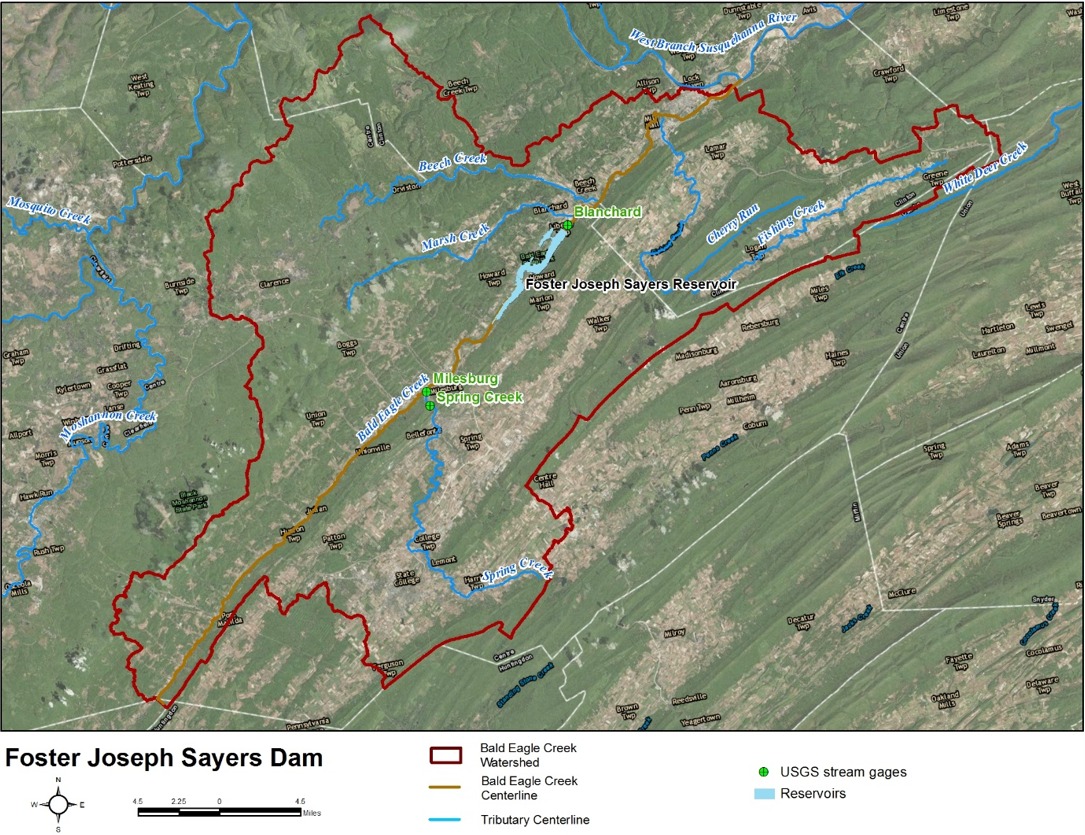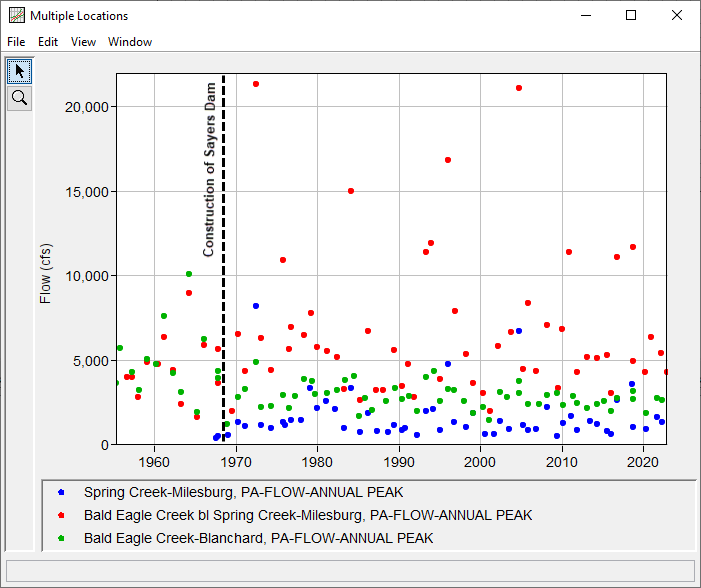Download PDF
Download page Mixed Population Analysis.
Mixed Population Analysis
Background
Multiple stream gages are operated by the Baltimore District (NAB) and United States Geologic Survey (USGS) in and around Foster Joseph Sayers Dam in Pennsylvania. The locations of the gages in relation to Bald Eagle Creek and Sayers Dam are shown in the following figure.

Annual peak flows at the Spring Creek at Milesburg, PA (Spring Creek), Bald Eagle Creek Bl Spring Creek at Milesburg, PA (Milesburg), and Bald Eagle Creek at Blanchard, PA (Blanchard) gages are shown in the following figure. This data can be retrieved using the USGS plugin within HEC-SSP.

Normally, stream gage records are relatively short (i.e. less than 100 years). However, within dam and levee safety studies, estimates of the magnitude of infrequent large floods are needed to adequately assess the risk associated with the structure(s) in question. Together with the observed record, a probability model (e.g. Log-Pearson Type III, Generalized Extreme Value, Log-Normal, etc.) is used to make inferences about these extremely rare floods.
In many watersheds, multiple types of flood-causing mechanisms are capable of generating large flows in a given year. The annual maximum flood for a given year is the largest of these flows. Generally, the annual maximum series (AMS) for a stream is analyzed without regard for the type of flood that caused each individual annual maximum; however, in many cases the AMS may be made of a mixture of floods of varying cause. A foundational assumption to estimating a population probability distribution from a limited sample is that the sample is representative of the population and made of independent and identically-distributed (IID) observations.
When multiple flood types create the AMS, the assumption of identical distribution can become tenuous, affecting the ability to make inferences about rare floods. Additionally, the behavior of the right-hand tail typically used in dam and levee safety studies may be dominated by a type of flood mechanism that is less dominant in the more-frequent part of the annual maximum flood frequency curve. Treating multiple flood types as separate, IID samples of floods of a particular cause allows for examination of the frequency of floods per type of flood. A mixed population analysis can then be used to combine the individual flood type maximum series into an annual maximum frequency curve that reflects the occurrence of more than one type of flood in a year.
Bald Eagle Creek is affected by different flooding mechanisms occurring on a seasonal basis, which means that the annual maximum series may contain floods caused by more than one mechanism. By splitting the record of daily flows at Milesburg into multiple seasons and analyzing them separately, the IID assumption made in analyzing the AMS can be more closely examined.
Objectives
In this workshop you will first gain experience filtering data sets to homogenize runoff mechanisms. Second, you will compute mixed population flow-frequency curves within HEC-SSP. Third, you will compare different ways of inputting the required data to the Mixed Population Analysis. Finally, you will compare the results of a Bulletin 17 flow-frequency analysis that did not separate multiple runoff mechanisms within a data set against the results of the Mixed Population Analysis. The following major tasks will serve as an outline for the workshop:
- Create a new HEC-SSP project and import daily flow data for the Milesburg gage location.
- Extract an all-season annual maximum series.
- Extract an annual maximum series for the summer and winter seasons.
- Fit the Log Pearson Type III distribution to each Annual Maximum Series.
- Create a Mixed Population Analysis using the summer and winter B17C results.
- Analyze the flow-frequency results.
Spend approximately 15 minutes per task to accomplish Tasks 1 - 6.
Continue to Task 1. Create a New HEC-SSP Project and Import Daily Flow Data for the Milesburg Gage Location.